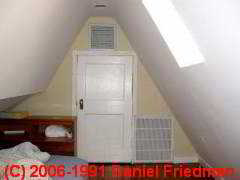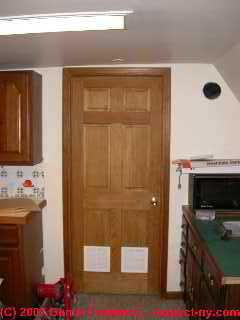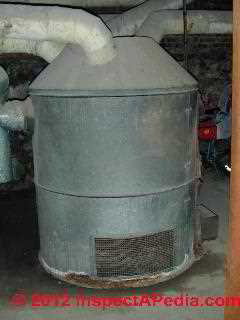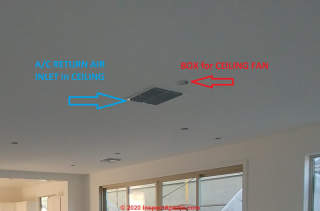Where To Place Ceiling Register Box
 Air Register Location
Air Register Location
Proper Placement of Heating or Cooling Registers & Ducts
- Postal service a QUESTION or COMMENT virtually the proper location for heating or cooling air registers
InspectAPedia tolerates no conflicts of interest. We accept no relationship with advertisers, products, or services discussed at this website.
HVAC heating & cooling air supply & return register locations:
Air conditioning (or Heating) Duct supply or return air register placement mistakes can increase cooling or heating costs, limit system chapters, and tin even exist dangerous.
This article describes the proper location and placement of air supply and air return registers in HVAC systems and addresses problems such as misplaced or missing air conditioning cool air supply or return air registers, improper cooling duct routing, cooling (or heating) air duct corrosion, and defective heating or cooling duct work.
This commodity is part of our series How to Inspect, Diagnose, & Repair the Air Conditioners or Estrus Pumps.
We as well provide an Commodity INDEX for this topic, or you can try the page height or bottom SEARCH BOX as a quick fashion to find data you need.
Location of ac & heating return & supply registers
 Supply and return too shut together consequence in short-circuiting
Supply and return too shut together consequence in short-circuiting
You don't have to be an HVAC design engineer to see that in the photo at page elevation and shown over again here the air conditioning supply register is above and but a few feet from the primal air-conditioning return grille.
Cool air delivered to this attic room from the supply register over the door will generally fall down to be only drawn right back into the return.
Ventilation and HVAC experts call this air movement curt-circuiting: the air being supplied is taking a shortcut right back into the return duct rather than mixing with air in the cooled or heated space.
Short-circuiting of ventilation air occurs when ventilation air enters and leaves a space or duct earlier it has a gamble to mix well enough with the room air to do the chore it was intended to do - that is, to adequately dilute pollutants, or to break upward stratified air in the occupied space. Occupants are left too cold or as well hot or they are left lament nearly poor indoor air quality. - adapted from Prozuments(2017).
Poor supply and return duct locations like this tin can severely reduce the effectiveness of the cooling system and increment its operating costs.
In this particular home the installer was confronted with a shoehorn retrofit of the air handler and duct work into a sub-standard attic chamber closet in an area where s/he was not permitted to open cathedral ceilings nor to construct a commitment duct along the ceiling or nether the floors.
It was a plush to operate and poor performing ac installation.
Location of Heating or Cooling Return Registers in Basements

The photograph above shows a basement door into which an installer cut 2 return air inlets to feed basement air back to an air return located at the basement air handler.
As we discussed at RETURN AIR, INCREASE, this is a poor design that increases heating or cooling organization operating costs. In improver to that issue, placement of return air inlets in basements, depending on their location, hazard other potential hazards including CO hazards.
Carbon monoxide hazards: Return air registers also close to oil or gas fired equipment may depict combustion gases or carbon monoxide into the air duct system, sending dangerous gases into the living infinite
Carbon monoxide production may be increased and heating fuel combustion incomplete at nearby heaters, water heaters, or fifty-fifty gas wearing apparel dryers, if the air handler is pulling return air from a bars space where combustion equipment is as well located.
Air-starved equipment may not simply work improperly, but may exist dangerous, producing dangerous carbon monoxide. We've also found this problem in basements where the owner, attempting to ameliorate basement air quality, ran powerful exhaust fans continuously.
Watch out: y'all should not commonly find persistent CO in indoor air. Carbon monoxide gas indoors is odorless and colorless and tin be fatal. Be sure your edifice has properly installed and working CO detectors and smoke detectors.
Placement of Heating or Cooling Air Returns at Exterior Walls

Heating or cooling return air duct systems which place the return annals at outside building walls may perform poorly.
Some heating authorities opine that more effective and economical design places these registers on the interior walls - the outside walls and perimeter of some rooms may be dank even when the heat is operating.
Other Bad Locations for Air Registers

Our photo to a higher place shows an octopus furnace located in the basement of a pre-1900 dwelling house. All of the render air to this system is drawn from the united nations-heated basement flooring - a "one-way" air movement heating design that increases heating costs too equally risking choice-up of dust, debris, or anything else undesirable from the basement area.
At UNSAFE DUCT OPENINGS we depict other air annals location mistakes that tin can exist dangerous, such every bit cutting a return air opening near heating equipment or in chancy areas similar a moisture moldy crawl infinite.
Reader Comments & Q&A
Isaac
Where you lot live and whether or not your duct system is used for both heating and cooling is pertinent in answering your excellent question about reutrn air inlet location.
If yous are asking whether or not the of of a stairway is a practiced location for an air return duct opening, my view is yes it is, particularly for air handling system when it is in cooling mode.
That's because warm air rises in buildings; locating an air return where warm air naturally rises (upwards the stairwell) .
Thank y'all for asking a helpful question. Don't hesitate to ask further if needed.
I have two levels in my home, each 1700 sf. It has been suggested to me that I can put a big air return for the ground flooring level at the summit of the staircase (ceiling) that goes from the ground level to the starting time level.
ceiling fan volition interfere with A/C return air?
 John
John
I oasis't found a AZ building lawmaking that explicitly mentions distance from supply register to electrical box
and I don't call up that causing a fan wobble is at all the effect here.
Rather the upshot is interference with air movement betwixt the future ceiling fan and the supply air annals. If the ceiling fan is pushing air DOWN it will reduce air flow into the returnn air inlet (which I suspect is rather small and so marginal in the first identify for a dwelling in increasingly-hot Arizona).
Looks iffy to me, besides. It's an air movement result;
Whether or not the fan wobbles is principally dependent on:
1. Apply of proper type of ceiling fan mounting box
2. Properly securing the ceiling fan mounting electrical box to building ceiling framing
3. Balancing the fan blades.
What is the minimum clearance betwixt an electrical box in the ceiling (for a ceiling fan) and an HVAC supply register? I saw this in my newly congenital house and I don't recall this is correct (picture attached). Is this upwards to code in AZ? or at least a smart thing to do? The electric box is in the heart of the living room. The vent is non a iv-fashion vent and volition be bravado direct at the fan. My assumption is that the ceiling fan will eventually neglect or wobble after a few cycles of getting straight cold air and heat.
Sorry I meant in ceiling above interior walls
@Mike Kegg,
My HVAC contractors put ceiling supply registers upstairs on interior walls, non above windows like I've always seen in the by. Is this a correct placement? This is new structure.
It'south ok to run ductwork through a closet, but if the air return inlet itself is in the closet in my view that is totally crazy. What: are you lot supposed to keep the closet door open all the time? Or maybe install a louvered cupboard door?
In trying to improve air menstruation, the contractor placed a return air duct in a closet. This seems counter-intuitive to me. Is this very efficient?
Ed
I can just guess that you desire heat distributed evenly in the warehouse and that there are no local estrus obstructions that would require an united nations-fifty-fifty distribution of supply registers.
Information technology might be that you need to close some of the vents in the beginning 30 ft. and you lot may nevertheless need to add some outlets in the 2nd 35 ft.
Making even some rough subjective measures of air flow at the diverse supply outlets will let yous rest the air flow.
Commercial contractor moving one-time hvac/ductwork to my new warehouse location. Had to add together about 35ft of duct to existing. 30ft At that place are 7 vents in showtime 30 feet (old duct) but he simply has 2 in the rest of the new 35ft. Looks totally messed up.
Where should the registers be in this configuration. Cant imagine Im getting any heating or cooling at the finish of the run and thats were I need to make sure I have some.
IMAGE LOST by older version of Clark Van Oyen's useful Comments code - now fixed. Please re-post the paradigm if you can. Sorry. Modern.
Chodak
Sounds as if yous need your HVAC company to inspect the abode, evaluate the HVAC system, be sure that its airflow is operating unremarkably - no dirty blower fan, blocked ducts, etc. When that's washed, a review of both supply and return duct location and openings can tell you where to add supply or return or both. As long as your heating arrangement has sufficient BTUh chapters and fan capacity it'll be only a question of price for correcting the duct system.
Simply sentinel out: do NOT take return air from anywhere too shut to a fuel -called-for device. Doing so is dangerous.
Basement is very cold winter no return in basement
Yes of course; it'southward a matter of time, problem, cost, impact on cooling organisation efficacy.
Can air filter annals in ceiling be moved?
You are describing a cross-connexion between return air ducts, between ii different air handlers. I'grand a fleck dislocated and may non have information technology right.
If the areas y'all are trying to cool are comfy I would non consider the expense of moving a render air duct.
We have a two story firm with ii systems in identify. The House has an opened ceiling format for the living room, so all the bedrooms(4) upstairs are supplied air from the cranium arrangement. Just, one of the returns is on the upper wall of this system, so it'southward pulling air from one unit of measurement'south surface area to the other'south. The master sleeping room has a return, but the smaller bedrooms don't. Do we need to move that render vent to one of the bedrooms?
Question: fume damage and ducts - furnace however blowing smoke
(July 24, 2014) rachael kelly said:
Wehad smoke harm a couple of years ago and now afterwards cleaning the walls smoke is even so blown out from furnace causing more
Reply:
Rachel,
Clearly your furnace needs repairs.
Question: will ceiling returns be adequate for firm heating?
(Aug 8, 2014) Dave said:
I'm having my firm rebuilt, I accept 800 sq ft on start floor (using 3 ton unit) and 1200 sq ft on second floor(using 4 ton unit). They are just putting returns in my ceiling and none closer to the flooring, my business concern is more near estrus and not so much AC...Will those returns in the ceiling heat my house? Doesn't heat ascension?
My contractor states because of how the supports for the second floor were installed information technology is extremely difficult to rn duct work down to the floor and that but the returns in the ceiling and oversized units volition be sufficient to cool and heat the firm. Any opinions? Thanks.
Reply:
Yes Dave, warm air rises, cool air falls.
If your design priority is for heating, not cooling, you might adopt to place return registers either in floors or in walls shut to floor level. You don't have to have the register all the style to the floor to make this improvement, just close to floor level.
I can't comment well-nigh the overall adequacy of the heating organization or cooling system designs, defective adequate data and possibly expertise. You'll want to have advice from an HVAC designer, engineer, or a similar expert.
Question: and then where should air supply and return registers be located?
(Jan iv, 2015) Anonymous said:
this page shows where NOT to place registers. Where do yous hash out correct or best placement?
Reply:
Thanks Betimes - good indicate. I'll work on the article above to add together some "DO's". I suppose I avoided those details for a couple of reasons: many locations are OK except the DONT's we listed, but still where to place an air supply or return register for best operation varies by whether nosotros are about interested in heating (identify those registers low on a wall and in an unblocked location) or in cooling (those registers are optimally placed loftier on walls or in ceilings).
In many buildings at that place are reasons that the installer will use not-optimal locations including for duct systems that have to deliver both heated and cooled air in different seasons.
Still I'll collect and add some other suggestions.
Thank you again.
Matt,
In general, A/C works better if delivered from high on walls - considering absurd air falls; when nosotros supply it from the floor or depression on walls the organisation is fighting gravity and will exist less efficient.
But I agree in part with Bearding that other factors such as return location, undercut doors, edifice layout, significantly affect airflow. For example, if render air is undersized or poorly located the ill furnishings of that will probably overshadow a supply annals that is too low.
@ Matt - No. Too much emphasis is put on whether or non the return air inlet should be located upwards high or low on a wall and non almost enough accent on properly sizing that return air inlet. Think most it this way.
One properly sized render inlet in a hall can return the air back to the unit of measurement for multiple rooms (such every bit a family unit room, hall, dining room, kitchen, foyer...). These rooms could exist l' away (laterally) from the return air inlet and yet the occupants comfort isn't compromised then locating the return air inlet vi' higher or lower on a wall isn't going to make whatever measurable difference.
@David - that'due south what I was thinking. Every bit long every bit the fan blades push button the air out from the height vent, and then a round cycle of air should result as it spews out and is sucked back in towards the air intake below.
I was just wondering though, would it be much better for an air conditioned to have the air intake at the top and the air intake at the bottom? Hot air rises so this seems to make more sense to me? I alive in Commonwealth of australia and then I would very rarely ever be concerned with heating.
@David - that'due south what I was thinking. As long as the fan blades button the air out from the peak vent, and then a circular cycle of air should outcome every bit it spews out and is sucked back in towards the air intake below.
I was just wondering though, would it be much better for an air conditioned to accept the air intake at the top and the air intake at the lesser? Hot air rises so this seems to make more sense to me? I alive in Australia so I would very rarely ever be concerned with heating.
Give thanks you for the welcom discussion, and for your HVAC short circuiting opinion, David.
I agree that coming out of a supply register the air velocity and the direction of the vanes on the register are factors that directly air into the room
I don't agree that placing supply and return ducts together is a adept practice nor can we support a postulate that short circuiting doesn't occcur when supply and render ducts are likewise close or poorly-located.
After all, in that location is velocity and "suction" at the render inlet only below that "throwing" motility of warm air at the supply register. When they're close together everyone with a smoke tester can about e'er encounter a dramatic plow in the out-flowing warm air from the supply if there is a return besides shut past.
Fundamental in your argument is "when properly-designed" - in our field feel we run across plenty of HVAC supply and return registers that were not "designed" at all.
Common heating and cooling air supply-return annals snafus past the installer include
- Supply and return short circuits every bit we've described on this page
- Nether-sized return so that the air handler is starved for return air - this is perhaps the most common snarl-upwardly we see in new structure
- Returns located and then as to kill building occupants past figting the gas burner for combustion air, producing fatal carbon monoxide
- Systems that draw all of their supply air from a cold basement or crawl infinite: a "one-manner" heating system that is as expensive to operate every bit possible
- and a host of other duct dilemmas encountered by inspectors and technicians in the field.
I welcome your further argument in this matter, David. Working together makes us smarter.
"the air conditioning supply register is above and simply a few anxiety from the central air conditioning return grille.
Absurd air delivered to this attic room volition mostly fall down to be just drawn right back into the return."
This is a very common misconception. When properly designed, the supply air that leaves a supply air register is "thrown" in the direction that the blades on the face of the register deflects it.
Supply air registers, in residential applications, will typically "throw" the air 12-20 feet.
This said, locating the render grille on the same wall as the supply annals can actually provide superior circulation, only only when the duct and annals have been sized properly and matched with a supply register that deflects the air in the appropriate management. In fact, in almost more confined rooms such every bit bedrooms, locating the supply air outlet on the same wall as the return air inlet will provide superior circulation the majority of the fourth dimension.
Imagine that you have an enclosed container that is full of water. On one side of the container, you lot cutting a hole and mountain the terminate of a garden hose to it. Correct side by side to that hole you install a bleed that is negatively pressurized "sucking".
When you lot turn the water on, the h2o is thrown horizontally towards the opposite side of the container. That water volition not return make the 180 degree alter in management until one of ii things happens. The jet of water looses all of information technology'southward speed (velocity) or the jet of water is redirected as a result of striking the reverse side of the container or some other obstruction. Remember that a specific corporeality of water is being thrown in a specific management and the bleed is sucking that same corporeality of water from any and all directions.
In addition, the jet of supply air really increases in volume every bit it travels across the room as a upshot of the venturi event. So not only does it non short wheel back into the return air inlet, it actually picks up boosted next air and moves information technology away from the return air.
is it ok to take a supply and return in each room?
we have sealed offf our basement heat vents--should they be left open?
should our basement hest vents exist left open?
Thank you lot for a great resource of information. =)
Basement door air gap - Can I block it? Two story house with two cold air returns on inside wall on each floor stocked over the same spot in the house and lead directly down to the A/C-Furnace (located center of the firm).
There are no vents almost any of the air returns. There is a noticeable air menstruation under the door leading to the basement during winter and summertime. With iv air returns already working, practise I need to keep the door to the basement unobstructed or tin I shut the air gap safely?
...
Proceed reading at AIR FLOW IMPROVEMENT, HVAC or select a topic from the closely-related manufactures below, or encounter the complete ARTICLE Index.
Or see these
Recommended Articles
- Return AIR REGISTERS & DUCTS
- SUPPLY DUCTS & REGISTERS
- DUCT SYSTEM DESIGN SIZE & DEFECTS - home
- WARM AIR STRATIFICATION INDOORS
Suggested commendation for this web page
LOCATION OF REGISTERS & DUCT at InspectApedia.com - online encyclopedia of building & environmental inspection, testing, diagnosis, repair, & problem prevention advice.
Or see this
Alphabetize to RELATED ARTICLES: Commodity INDEX to HVAC DUCT SYSTEMS
Or apply the SEARCH BOX found below to Ask a Question or Search InspectApedia
...
Inquire a Question or Search InspectApedia
Endeavor the search box just below, or if you lot prefer, post a question or comment in the Comments box below and we will respond promptly.
Search the InspectApedia website
Annotation: appearance of your Annotate below may be delayed: if your comment contains an prototype, web link, or text that looks to the software as if it might be a spider web link, your posting volition appear after information technology has been canonical by a moderator. Apologies for the delay. Our Comment Box is provided by Countable Web Productions countable.ca
Technical Reviewers & References
Click to Show or Hide Citations & References
Publisher InspectApedia.com - Daniel Friedman
Where To Place Ceiling Register Box,
Source: https://inspectapedia.com/aircond/Air_Duct_Register_Location.php
Posted by: hendersonention.blogspot.com


0 Response to "Where To Place Ceiling Register Box"
Post a Comment